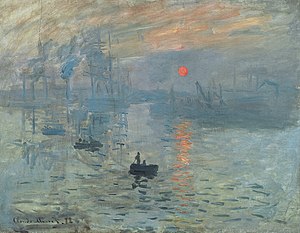Impression, sunrise

|
| Impression, sunrise |
|---|
| Claude Monet , 1872 |
| Oil on canvas |
| 48 × 63 cm |
| Marmottan Monet Museum , Paris |
Impression, Sunrise ( French Impression, Soleil levant ) is a seascape by the French painter Claude Monet from 1872, which gave the Impressionism its name.
description
The picture shows the port of Le Havre in the morning. Ships are anchored in the background, disappearing in the fog. In the foreground of the picture three smaller fishing boats can be seen unclearly. The light of the rising sun breaks on the water.
Monet painted most of the picture with violet and blue, and the reflection of the sun on the water with orange. Industrial plants and ships in the background, whose masts and shadow outlines create linear structures, serve as structuring elements. The picture is painted so evenly that the appearance of the spatial distance is only clear through the sloping boats.
Monet renounces composition and spatial effect . The aim of the presentation is the unadulterated reproduction of the momentary objective visual impression. The atmospheric impression is in the foreground and rejects the shape of objects. In order to realize his ideas, Monet used a painting style with small, short brushstrokes, which makes the constant interplay of light and the flickering air vivid.
The paint is applied so thinly ( glazed ) in places that the canvas shines through. Only the reflections of the sun stand out.
history
- exhibition
From April 15 to May 15, 1874, Monet, Camille Pissarro , Alfred Sisley , Auguste Renoir , Paul Cézanne , Edgar Degas and a total of thirty other artists exhibited their own pictures, as they were mostly rejected at the Paris Salon . Most of the visitors were appalled by the experiments and outraged by such "graffiti". The greatest sensation caused Monet's picture, which most viewers said they could not even see what was being depicted.
The criticism of the lack of execution of the exhibited pictures, which were nothing more than sketches, meant that the visitors stayed away and the costs could not be covered. Nevertheless, the term “impressionists” quickly became established and was consciously chosen by the artists participating in another exhibition when they gave it the title “exposure of the impressionist”.
- Surname
Monet created this picture from a high hotel window during a stay in Le Havre. With its sketchiness, it represented something completely new and was heavily criticized and frowned upon for it. Because of the high level of abstraction, he did not want to call the painting the port of Le Havre and said:
“I should give a title for the catalog; since I could hardly call the picture 'View of Le Havre', I said: 'Call it Impression.' "
Monet would have loved to have given all of his pictures that title.
- robbery
On October 27, 1985 armed robbers broke into the Musée Marmottan Monet during opening hours and tore the picture Impression, Sunrise and eight other works by Monet from the walls. The pictures were not found again until five years later.
reception
Because of its sketchiness, the work came under heavy criticism. For example, in 1874, after the first group exhibition , the art critic Louis Leroy wrote :
"A wallpaper in its original state is more elaborate than this seascape."
He meant that the simplest wallpaper pattern was artistically more demanding than this picture and, based on this picture, also referred to the first group exhibition of the “ Sociéte Anonyme Coopérative d 'Artistes-Peintres, Sculpteurs, Engravers, etc. ” as an “ Exhibition der Impressionists ”, with which he gave the whole style its name.
The British author Sr. Wendy Beckett writes:
“Impressionism was officially 'born' in 1874, when this term coined a relatively heterogeneous group of artists who exhibited in the Salon des Refusés that year. The spontaneity of many of the works seemed rather rough and unfinished, which angered the critics. Although these artists were distinctly individualists with different ideas and goals, they were united by the desire to achieve a natural appearance, and their work showed an amazingly modern freshness and luminosity. "
literature
- Wendy Beckett : " The History of Painting: 8 Centuries of Occidental Art in 455 Masterpieces ". Cologne DuMont, 1995. ISBN 3-7701-3560-1 .
- Karin Sagner : " Claude Monet ". Cologne: DuMont, 2005. ISBN 3-8321-7598-9 .
- Manfred Wundram : " The most famous paintings in the world ". Bergisch-Gladbach: Imprimatur Druck- und Verlagsgesellschaft, 1976